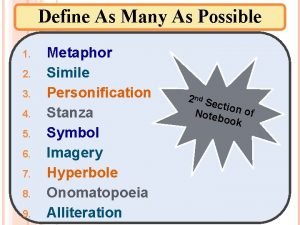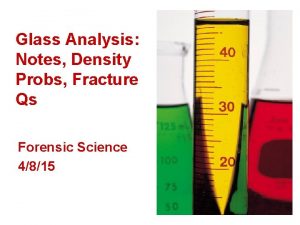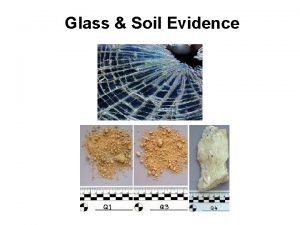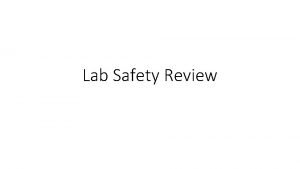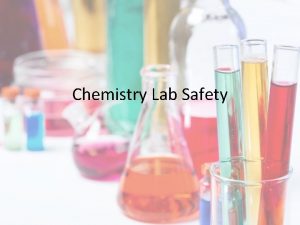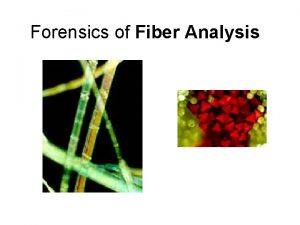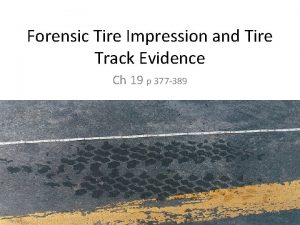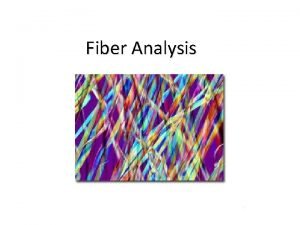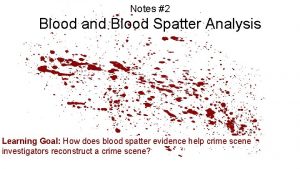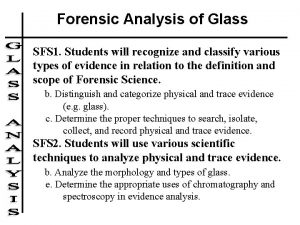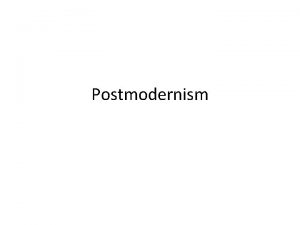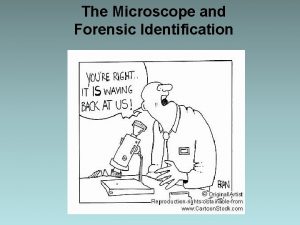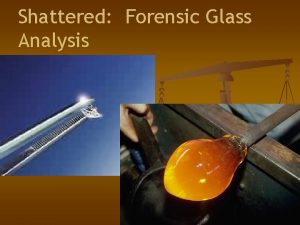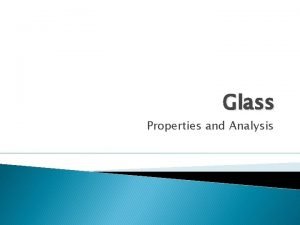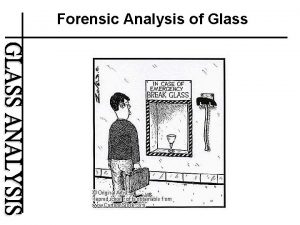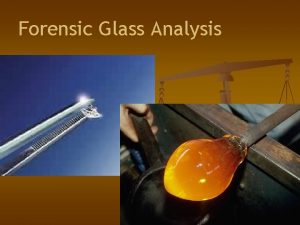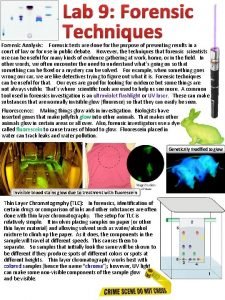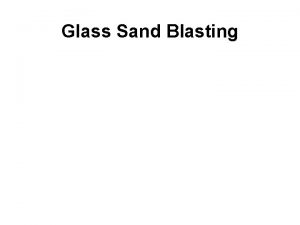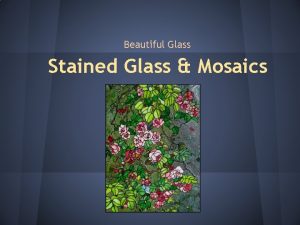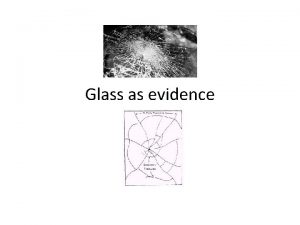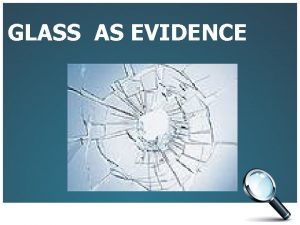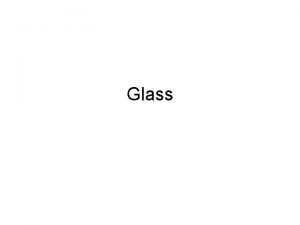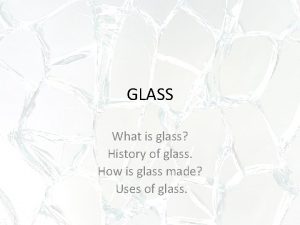Shattered Forensic Glass Analysis What is Glass n





























- Slides: 29

Shattered: Forensic Glass Analysis

What is Glass? n n n “An inorganic product of fusion which has cooled to a rigid condition without crystallizing” Uniform amorphous solid No specific m. p. Softens over a temperature range

'Ordinary' sheet glass -made by passing the molten glass through rollers; process gives an almost flat finish but with distortions. -glass is used in glazing greenhouses and garden sheds where the visual distortions do not matter. Float glass (plate) Float glass gets its name from the method of production used to manufacture it. -molten glass is 'floated' onto a bed of molten tin -produces a glass which is flat and distortion free -process imparts a fluorescence to the glass [UV light]

Rolled Glass Float Glass Process

Toughened (Safety glass) -glass is produced by applying a special treatment to ordinary float glass after it has been cut to size and finished. -treatment involves heating the glass so that it begins to soften (about 620 C) and then rapidly cooling it. -produces a glass which, if broken, breaks into small pieces without sharp edges. Laminated glass -glass is made up of a sandwich of two or more sheets of glass (or plastic), bonded together by a flexible, normally transparent material. -if cracked or broken, the flexible material is designed to hold the glass fragments in place.

What’s in Glass? n n n Network Components-Formers: Si. O 2, B 2 O 3, P 2 O 5, Ge. O 2, V 2 O 5, As 2 O 3, Sb 2 O 5 Fluxes–Softeners [lowers melting point]: Na 2 O, K 2 O, Li. O, Al 2 O 3, B 2 O 3, Cs 2 O Stabilizers–Chemical/Corrosion Resistance: Ca. O, Mg. O, Al 2 O 3, Pb. O, Sr. O, Ba. O, Zn. O, Zr. O

Major Types and Uses n Soda lime silicate glass Si. O 2 + Na 2 O / K 2 O + Ca. O / Al 2 O 3 / Mg. O n n Flat glass, container glass, electric light bulbs Borosilicate glass > 5% B 2 O 3 (replaces Na 2 O) Lab glassware, thermometers, cookware, sealed-beam headlights

n Aluminosilicate glass Higher percentage of aluminum n higher temperatures than borosilicate n Aluminoborosilicate – 50: 50 Al/B n Labware, cookware, and glass fibers n n Lead alkali silicate (leaded glass) Up to 80% Pb. O n high refractive index n “Crystal” tableware, n

Different glasses-domestic windows, car headlamps, light bulb glass-are produced differently from different chemistries.

Forensic Individualization of Glass n Flat Glass–Soda lime silicate -Rolling or Floating n Tempered: Rapid Cooling Adds Strength n Dices when broken n Automotive windows & security windows n Float Glass floresces when excited at 254 nm. n

n Coated: Surface modification n n Mirrors Laminated: Sandwiched around plastic n Automotive windshields Headlights: often borosilicate n Light bulbs: soda lime glass n Heat absorbing/ UV filtering n n n tinting Eyeglasses: prescription lenses/photosensitive

n Container Glass Lower magnesium, higher sodium n Clear vs. greenish (window) n n Glass Fiberglass insulation n Alumino-borosilicate n Binder (red or yellow) to hold fibers in bundles n

Forensic Analysis of Glass Fundamental Question: Is it Glass? n Isotropic vs. Anisotropic n Glass: Isotropic n n Crystalline solids and plastics: Anisotropic n n n dark when rotated under crossed polarizers Change retardation when rotated under crossed polarizers Hardness Solubility

Comparison of Physical Characteristics n n Color Flatness Thickness Fluorescence–Float Glass n 254 nm

Physical Properties n Density n Sink-Float Method n n CHBr 3, C 2 H 2 Br 4, Sodium Polytungstate Density Range: 2. 465 -2. 540 g/cm 3

When 2 substances have different RI, light passing through them produces a Becke Line A Becke line is a band or rim of light visible along a grain/crystal boundary in plane-polarized light.


Glass analysis is often performed using our old friend the PLM -the goal of glass analysis by PLM is to individualize an evidence glass fragment to an exemplar from a crime scene [primary or secondary]

Populations of Glass RIs

GRIM II System -automated system for matching glass RI -uses a step-heating stage and a RI liquid that varies with temperature

GRIM II identifies the RI match by monitoring a video image of the glass fragment in the liquid -as it is heated/cooled the contrast is measured until a minimum is reached-the match point

n Chemical Composition – n n Inductively Coupled Plasma (ICP) SEM/EDS Neutron Activation Analysis X-Ray Fluorescence

How does Glass break? Forensic Fracture Analysis

Radial Begin at a point and radiate outward from point of impact -initial crack is on the side opposite the applied force

Concentric Motion of the projectile through the glass puts tension on the front surface of the glass, causing concentric fractures. -high-speed projectile [a rock] penetrates the glass, it leaves an exit hole larger than it's entrance hole. -helps to determine the direction on impact.

A determination of the direction of force in breaking a window pane: -direction of the rib marks [stress marks on broken edges of glass that are perpendicular to one side of glass] For radial fractures (radiating from the center): - the direction of the force is on the same side as the tangential parts of the rib marks.

Bullets and Glass It’s possible to determine the bullet's direction by noting the side of the coneshaped hole left by the bullet. -small opening is on the entrance side

Counting Bullet Holes Determination of the sequence of bullet holes can be made by noting the radial fractures. Radial fractures caused by the passage of a bullet stop at preexisting fracture.

 Shattered glass
Shattered glass Shattered dvd9
Shattered dvd9 The eerie silence was shattered by her scream
The eerie silence was shattered by her scream Restoring the shattered self
Restoring the shattered self Forensic glass analysis
Forensic glass analysis Radial fracture
Radial fracture Forensic anthropologist vs forensic pathologist
Forensic anthropologist vs forensic pathologist Who is this
Who is this Glass evidence in forensic science
Glass evidence in forensic science Glass ceiling vs glass escalator
Glass ceiling vs glass escalator If an acid is splashed on your skin, wash at once with
If an acid is splashed on your skin, wash at once with Does hot glass look like cold glass
Does hot glass look like cold glass Forensic handwriting analysis video
Forensic handwriting analysis video Why are fibers important to forensics
Why are fibers important to forensics Tire impressions
Tire impressions Fibers from animals
Fibers from animals This process is useful in the examination of watermarks
This process is useful in the examination of watermarks Morphology in forensics
Morphology in forensics Owasp cloud top 10
Owasp cloud top 10 Forensic files blood spatter analysis
Forensic files blood spatter analysis The lady in the looking glass
The lady in the looking glass Glass house & philip johnson analysis
Glass house & philip johnson analysis A chip of glass ruby by nadine gordimer
A chip of glass ruby by nadine gordimer Symbols in the glass roses
Symbols in the glass roses Pyrex glass forensics
Pyrex glass forensics The glass mountain donald barthelme analysis
The glass mountain donald barthelme analysis What characteristics make hair a useful forensics tool
What characteristics make hair a useful forensics tool Hegar's sign
Hegar's sign Forensic magnifier
Forensic magnifier Cibin
Cibin


